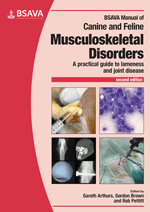
Full text loading...

This chapter provides an overview of the anatomy and physiology of muscle, tendon and ligament, as well as detailing muscle injury, healing and treatment; tendon and ligament injury and treatment; specific muscle and tendon injuries of the thoracic and pelvic limbs; and muscle contracture.
Muscle, tendon and ligament injuries, Page 1 of 1
< Previous page | Next page > /docserver/preview/fulltext/10.22233/9781910443286/9781910443286.9-1.gif

Full text loading...























